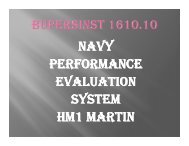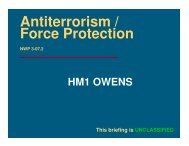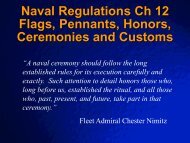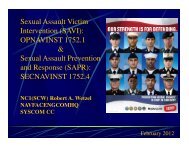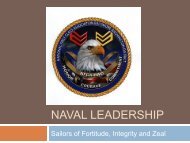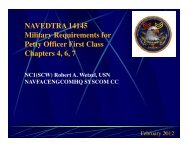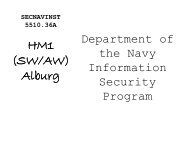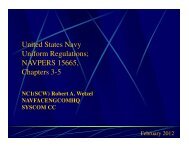Military Requirements for Petty Officers Third and Second Class ...
Military Requirements for Petty Officers Third and Second Class ...
Military Requirements for Petty Officers Third and Second Class ...
Create successful ePaper yourself
Turn your PDF publications into a flip-book with our unique Google optimized e-Paper software.
<strong>Military</strong> <strong>Requirements</strong><br />
<strong>for</strong> <strong>Petty</strong> <strong>Officers</strong><br />
<strong>Third</strong> <strong>and</strong> <strong>Second</strong> <strong>Class</strong><br />
Chapters 5-8<br />
HM1 (SW/AW) Alburg
<strong>Military</strong> <strong>Requirements</strong><br />
<strong>for</strong> <strong>Petty</strong> <strong>Officers</strong><br />
<strong>Third</strong> <strong>and</strong> <strong>Second</strong> <strong>Class</strong><br />
NAVEDTRA 14504<br />
Chapter 5
NAVEDTRA 14504<br />
With regards to the <strong>Military</strong><br />
(you <strong>and</strong> me), what title does<br />
the President of the United<br />
States hold?<br />
Hail to the chief we have chosen <strong>for</strong> the Nation
NAVEDTRA 14504<br />
Comm<strong>and</strong>er In Chief
NAVEDTRA 14504<br />
What article <strong>and</strong> section of the<br />
Constitution provides that the<br />
executive power shall be vested<br />
in a President of the United<br />
States?
NAVEDTRA 14504<br />
Article II, section 1, of the<br />
Constitution provides that the<br />
executive power shall be vested<br />
in a President of the United<br />
States of America
Crazy Question!!!!<br />
How long is the President’s term<br />
of office?<br />
How many terms can he/ she<br />
serve?
Crazy Question!!!!<br />
4 years<br />
2
Comm<strong>and</strong>er In Chief<br />
• The President, as the Comm<strong>and</strong>er<br />
In Chief, heads the military<br />
chain of comm<strong>and</strong> within the<br />
Department of Defense (DoD)<br />
• The Comm<strong>and</strong>er In Chief is kept<br />
abreast of all matters affecting<br />
the ability of the DoD to defend<br />
the United States <strong>and</strong> its allies
<strong>Military</strong> Forces<br />
• As of 1999, the major elements<br />
of these <strong>for</strong>ces are the Army,<br />
Navy, Marine Corps, <strong>and</strong> Air<br />
Force, consisting of<br />
approximately 1.4 million men<br />
<strong>and</strong> women on active duty
Department of Defense<br />
• The DoD is comprised of the<br />
offices of the Secretary of<br />
Defense (SECDEF), the Joint<br />
Chiefs of Staff (JCS) <strong>and</strong> their<br />
supporting establishments (the<br />
Departments of the Army, Navy,<br />
<strong>and</strong> Air Force), <strong>and</strong> various<br />
unified <strong>and</strong> specified comm<strong>and</strong>s.<br />
• The DoD carries out the military<br />
policies of the United States
DoD<br />
President<br />
(Comm<strong>and</strong>er in<br />
Chief)<br />
Secretary of<br />
Defense<br />
Deputy<br />
Secretary<br />
of Defense<br />
Department<br />
of the Army<br />
Department<br />
of the Navy<br />
Department<br />
of the Air Force<br />
Office of the<br />
Secretary of<br />
Defense<br />
Inspector<br />
General<br />
Joint Chiefs of<br />
Staff<br />
CNO<br />
Navy Major<br />
Comm<strong>and</strong>s<br />
<strong>and</strong> Agencies<br />
You
DoD<br />
DoD’s function, simply stated, is to<br />
maintain <strong>and</strong> employ armed <strong>for</strong>ces to<br />
accomplish the following:<br />
• Support <strong>and</strong> defend the Constitution of the<br />
United States against all enemies<br />
• Protect the United States, its possessions,<br />
<strong>and</strong> areas vital to its interests<br />
• Advance the policies <strong>and</strong> interests of the<br />
United States<br />
• Safeguard the internal security of the United<br />
States
Secretary of Defense<br />
(SECDEF)<br />
• Heads the DoD<br />
• Is appointed to the President’s<br />
cabinet <strong>and</strong> the National<br />
Cabinet Security Counsel
Recap Question….<br />
As of 1999, what are the four<br />
(4) major elements of the<br />
military <strong>for</strong>ces?
Recap Question….<br />
Army, Navy, Marine Corps <strong>and</strong><br />
Air Force
Recap Question….<br />
Who heads the Dod?
Recap Question….<br />
SECDEF
NAVEDTRA 14504<br />
• Under the President, the SECDEF, by<br />
virtue of an executive order, has<br />
responsibility <strong>for</strong> all the<br />
President’s functions involving the<br />
DoD.<br />
• Those functions include the<br />
President‘s powers, duties <strong>and</strong><br />
authorities
Joint Chiefs of Staff<br />
• Consists of the Chairman, the Vice<br />
Chairman the Chief of Staff US Army,<br />
the Chief of Naval Operations, the<br />
Chief of Staff US Air <strong>for</strong>ce, <strong>and</strong> the<br />
Comm<strong>and</strong>ant of the Marine Corps.<br />
• The Chairman is the principal<br />
military advisor to the President.<br />
• The Chairman holds the rank of<br />
general or admiral <strong>and</strong> outranks all<br />
other officers of the armed <strong>for</strong>ces.
Department of the Air Force<br />
• Established on Sept 18, 1947<br />
• They are responsible <strong>for</strong><br />
defending the United States<br />
through control <strong>and</strong><br />
exploitation of air <strong>and</strong><br />
space
Department of the Army<br />
• Established by the<br />
Continental Congress on<br />
June 14, 1775<br />
• The Army focuses on l<strong>and</strong><br />
operations
Department of the Navy<br />
United States Marine Corps<br />
• Established on Nov 10,<br />
1775<br />
• The Marines are able to<br />
fight on l<strong>and</strong>, air or sea
Which of the following is the most<br />
senior officer in the armed <strong>for</strong>ces?<br />
1) Comm<strong>and</strong>ant of the Marine Corps<br />
2) Chief of Naval Operations<br />
3) Chairman of the Joint Chiefs of<br />
Staff<br />
4) Secretary of Defense<br />
3) Chairman of the Joint Chiefs<br />
of Staff
Who serves as the spokesman <strong>for</strong> the<br />
comm<strong>and</strong>ers of the unified combatant<br />
comm<strong>and</strong>?<br />
1) Comm<strong>and</strong>er of the U.S. Joint<br />
Forces Comm<strong>and</strong><br />
2) Chairman of the Joint Chiefs of<br />
Staff<br />
3) Secretary of the Army<br />
4) Secretary of the Air Force<br />
2) Chairman of the Joint Chiefs of<br />
Staff
What rank does the Chairman of<br />
the Joint Chiefs of Staff hold?
The Chairman of the Joint Chiefs<br />
of Staff holds the rank of<br />
General or Admiral <strong>and</strong> outranks<br />
all other officers in the<br />
military
Other Department of Defense Agencies<br />
• Ballistic Missile Defense Organization<br />
• Defense Advanced Research Projects Agency<br />
• Defense Commissary Agency<br />
• Defense Contract Audit Agency<br />
• Defense Finance <strong>and</strong> Accounting Service<br />
• Defense In<strong>for</strong>mation Systems Agency<br />
• Defense Intelligence Agency<br />
• Defense Legal Service Agency<br />
• Defense Logistics Agency<br />
• Defense Security Service<br />
• Defense Threat Reduction Agency<br />
• National Imagery <strong>and</strong> Mapping Agency
Department of the Navy<br />
• Primary mission is to protect the<br />
United States, as directed by the<br />
President or the SECDEF, by the<br />
effective prosecution of war at sea<br />
including, with its Marine Corps<br />
component, the seizure or defense of<br />
advanced naval bases; to support, as<br />
required, the <strong>for</strong>ces of all military<br />
departments of the United States; <strong>and</strong><br />
to maintain freedom of the seas
Chief of Naval Operations<br />
• The Chief of Naval Operations (CNO),<br />
under the direction of SECNAV, takes<br />
precedence above all other officers of<br />
the naval service<br />
• The CNO is the Navy member of the<br />
Joint Chiefs of Staff<br />
• The CNO, under the Secretary of the<br />
Navy, exercises comm<strong>and</strong> over certain<br />
central executive organizations,<br />
assigned shore activities, <strong>and</strong> the<br />
Operating Forces of Navy
Master Chief <strong>Petty</strong> Officer of<br />
the Navy (MCPON)<br />
• Serves as the senior enlisted<br />
representative of the Navy.<br />
Started in 1966 by the CNO to<br />
help with retention. The office<br />
was <strong>for</strong>mally set up on 1 March<br />
1967 with a tour length of four<br />
years<br />
• The MCPON reports directly to the<br />
CNO regarding matters on active<br />
duty <strong>and</strong> retired enlisted members<br />
<strong>and</strong> their dependents
Comm<strong>and</strong>ant of the Marine Corps<br />
• The Comm<strong>and</strong>ant of the Marine<br />
Corps (CMC) comm<strong>and</strong>s the Marine<br />
Corps<br />
• The comm<strong>and</strong>ant is directly<br />
responsible to SECNAV <strong>for</strong> the<br />
administration, discipline,<br />
internal organization, training<br />
requirements, efficiency,<br />
readiness, <strong>and</strong> total per<strong>for</strong>mance<br />
of the Marine Corps
The Master Chief <strong>Petty</strong> Officer<br />
of the Navy is assigned to<br />
what immediate office?<br />
1) Chief of Naval Personnel<br />
2) Chief of Naval Operations<br />
3) Secretary of the Navy<br />
4) Assistant Secretary of the<br />
Navy<br />
2) Chief of Naval Operations
The Pacific Fleet’s area of<br />
responsibility includes which<br />
of the following area?<br />
1) Southeast Asia<br />
2) Arctic Ocean<br />
3) U.S. west coast<br />
4) Both 2 <strong>and</strong> 3<br />
4) Both 2 <strong>and</strong> 3
Safety <strong>and</strong> Hazardous Materials<br />
In<strong>for</strong>mation <strong>for</strong> the <strong>Petty</strong> Officer<br />
Chapter 6
Safety <strong>and</strong> Hazardous Materials<br />
In<strong>for</strong>mation <strong>for</strong> the <strong>Petty</strong> Officer<br />
Ultimate responsibility <strong>for</strong> the<br />
safety of the unit lies with the<br />
comm<strong>and</strong>ing officer, <strong>and</strong> each<br />
individual plays a part in that<br />
safety
Safety <strong>and</strong> Hazardous Materials<br />
In<strong>for</strong>mation <strong>for</strong> the <strong>Petty</strong> Officer<br />
SAFETY IS AN ALL-HANDS<br />
RESPONSIBILITY
Division Safety <strong>Petty</strong> Officer<br />
is responsible <strong>for</strong> mishap<br />
prevention training <strong>and</strong><br />
maintaining appropriate records
Master-at-arms/Safety Force<br />
• The master-at-arms (MAA)/safety<br />
<strong>for</strong>ce is a vital link in the<br />
unit safety<br />
• The MAA/safety <strong>for</strong>ce acts as a<br />
roving inspector <strong>for</strong> hazards<br />
<strong>and</strong> risks (unsafe work<br />
practices) that could result in<br />
injury to personnel or damage<br />
to equipment
R<strong>and</strong>om Question….<br />
Which of the following items<br />
promotes safety awareness?<br />
1. Posters<br />
2. Caution signs<br />
3. Inspections<br />
4. All of the above
R<strong>and</strong>om Question….<br />
1. Posters<br />
2. Caution signs<br />
3. Inspections<br />
4. All of the above
The objective of any safety program<br />
is to improve operational readiness.<br />
1) True<br />
2) False<br />
1) True
Who is responsible <strong>for</strong> mishap prevention<br />
training <strong>and</strong> maintaining appropriate<br />
records?<br />
1) Executive Officer<br />
2) Comm<strong>and</strong> master chief<br />
3) Division Safety <strong>Petty</strong> Officer<br />
4) All h<strong>and</strong>s<br />
3) Division Safety <strong>Petty</strong> Officer
Safety Council<br />
• Large comm<strong>and</strong>s may have a<br />
safety organization<br />
• As the Division Safety <strong>Petty</strong><br />
Officer, you may serve as the<br />
representative of your division<br />
• Meets monthly
Tag-out Logs<br />
• Used to control the entire tagout<br />
procedure.<br />
• It is a record of authorization<br />
of each effective tag out action.<br />
• Contains a copy of the main tagout<br />
instruction, a DANGER/CAUTION<br />
tag-out index <strong>and</strong> a cleared<br />
DANGER/CAUTION tag-out record.
After the tags are cleared <strong>and</strong><br />
the record sheet is filled<br />
out, where would you place the<br />
sheet?<br />
At the back of the tag-out<br />
log in the cleared section
Hazardous Materials<br />
(HAZMATS)<br />
• Any material that, because of its<br />
quality, concentration, or physical or<br />
chemical characteristics, may pose a<br />
real hazard to human health to the<br />
environment<br />
• Includes: Flammable <strong>and</strong> Combustible<br />
Materials, Toxic Materials, Corrosive<br />
Materials, Oxidizers, Aerosols,<br />
Compressed Gases<br />
• Hazardous Materials In<strong>for</strong>mation<br />
System(HMIS) is a computerized<br />
database of material safety data<br />
sheets (MSDSs)
Occupational Safety <strong>and</strong> Health<br />
Administration passed a<br />
regulation that requires all<br />
civilian <strong>and</strong> military<br />
employees of the federal<br />
government to comply with what<br />
regulation?<br />
Hazard Communication St<strong>and</strong>ard
MISSION ORIENTED PROTECTIVE<br />
POSTURE<br />
• procedures are used to establish<br />
levels of readiness <strong>for</strong> a chemical<br />
agent attack<br />
• The procedures are flexible<br />
• They allow the comm<strong>and</strong>ing officer (CO)<br />
to adapt the requirements <strong>for</strong><br />
protective clothing <strong>and</strong> equipment to<br />
the degree of the threat <strong>and</strong> working<br />
conditions at any given time
RISK ASSESSMENT<br />
defined as the assessed difference<br />
between the threat level <strong>and</strong> the<br />
activation of appropriate levels of<br />
shipboard countermeasures
MISSION ORIENTED PROTECTIVE<br />
POSTURE<br />
How many levels of MOPP<br />
are there?
MISSION ORIENTED PROTECTIVE<br />
POSTURE<br />
4
MISSION ORIENTED PROTECTIVE<br />
POSTURE<br />
MOPP procedures used to<br />
establish levels of readiness<br />
<strong>for</strong> a chemical agent attack<br />
are flexible.<br />
1. True<br />
2. False
MISSION ORIENTED PROTECTIVE<br />
POSTURE<br />
True
CBR threat can be categorized into<br />
four levels of probability:<br />
SUSPECTED<br />
• An adversary who has CBRcapable<br />
delivery systems within<br />
the operations area (OPAREA)<br />
presents a suspected threat<br />
• Implementation of MOPP-1<br />
countermeasures is indicated
CBR threat can be categorized into<br />
four levels of probability:<br />
POSSIBLE<br />
• The expressed affirmation or<br />
assessed political will of an<br />
adversary to use CBR warfare<br />
increases the threat potential<br />
to a possible involvement in a<br />
CBR environment<br />
• Implementation of MOPP-2<br />
countermeasures is indicated
CBR threat can be categorized into<br />
four levels of probability:<br />
PROBABLE<br />
• Statements of intent to employ CBR warfare,<br />
directed at U.S. <strong>for</strong>ces or allies, changes in<br />
political or military posture of an adversary<br />
possessing CBR capabilities, or use of CBR<br />
warfare within the OPAREA present a chance of<br />
probable involvement in a CBR environment<br />
• This threat level requires an estimate of the<br />
earliest time the CBR environment will be<br />
encountered<br />
• This estimate must be based on the strike<br />
ranges of delivery systems <strong>and</strong> the time it<br />
takes the strike to arrive at the nearest<br />
range limits<br />
• Implementation of MOPP-3 countermeasures is<br />
indicated
CBR threat can be categorized into<br />
four levels of probability:<br />
IMMINENT<br />
• Confirmation of increased<br />
activity involving delivery<br />
systems, recognized plat<strong>for</strong>m<br />
attack patterns, electronic or<br />
visual indication of employment<br />
of delivery systems, or the<br />
immediate proximity of known CBR<br />
hazard areas present an imminent<br />
danger of contamination <strong>and</strong>/or<br />
casualties<br />
• Implementation of MOPP-4<br />
countermeasures is essential
Readiness condition III (wartime steaming)<br />
is set during what MOPP level?<br />
1) 1<br />
2) 2<br />
3) 3<br />
4) 4<br />
1) 1
Damage Control <strong>Petty</strong> Officer<br />
• Makes damage control closure<br />
log entries.<br />
• Maintains damage control<br />
fittings <strong>and</strong> equipment.
Damage Control Closure Log<br />
• The closure log is maintained at<br />
all times, whether the ship is in<br />
port or underway<br />
• Shows the location where the<br />
existing material condition has<br />
been modified. The type of<br />
fitting; the name of who requested<br />
permission to open or close the<br />
fitting, the date <strong>and</strong> time the<br />
fitting was opened or closed <strong>and</strong><br />
the name <strong>and</strong> rate/rank of the<br />
person granting the permission.<br />
• The damage control closure log is<br />
normally kept on the quarterdeck in<br />
port, on the bridge at sea, <strong>and</strong> in<br />
damage control central (DCC) during<br />
general quarters.
St<strong>and</strong> <strong>and</strong> Stretch….
Supply Procedures<br />
Chapter 7
Basic Supply Terms<br />
• Controlled Equipage - Items requiring special management<br />
control because the material is essential to protection of<br />
life or is relatively valuable <strong>and</strong> can be converted easily<br />
<strong>for</strong> personal use.<br />
• Logistics - The science of planning <strong>and</strong> carrying out the<br />
movement <strong>and</strong> maintenance of military <strong>for</strong>ces.<br />
• Material - All items necessary to equip, operate, maintain,<br />
<strong>and</strong> support an activity.<br />
• Supplies - All items necessary to equip, maintain, <strong>and</strong><br />
operate a military comm<strong>and</strong>, including food, clothing,<br />
equipment, arms, ammunition, fuel, materials, <strong>and</strong> machinery<br />
of all types.<br />
• Supply - The procurement, distribution, maintenance (while in<br />
storage), <strong>and</strong> salvage of supplies, including the<br />
determination of the type <strong>and</strong> quality of supplies.<br />
• Supply Control - The process by which an item of supply is<br />
controlled within the supply system, including<br />
requisitioning, receipt, storage, stock control, shipment,<br />
disposition, identification, <strong>and</strong> accounting.
Stock <strong>and</strong> Control Numbers<br />
• Stock <strong>and</strong> control numbers are used to<br />
identify <strong>and</strong> order material in the<br />
supply system<br />
• The identification numbers are known<br />
as:<br />
-national stock numbers (NSNs),<br />
-NATO stock numbers (a variation of<br />
the NSN)<br />
-Navy item control numbers, <strong>and</strong><br />
-local item control numbers.
National Stock Numbers<br />
• Is a 13-digit number consisting of a 4-digit<br />
federal supply classification (FSC) code number<br />
<strong>and</strong> a 9-digit national item identification<br />
number (NIIN)<br />
• Most commonly used<br />
• The federal supply classification (FSC) number<br />
identifies an item by commodity or description;<br />
the first two digits of the FSC are called the<br />
FSC group (denoting the group or major division<br />
of the commodities; ex: hardware <strong>and</strong> abrasives),<br />
<strong>and</strong> the last two digits of the FSC are called<br />
the FSC class (denoting the class or subdivision<br />
within a group; ex: screws are a subdivision of<br />
the FSC group, hardware <strong>and</strong> abrasives).<br />
• The national item identification number (NIIN)<br />
identifies each item of supply used by the DoD<br />
<strong>and</strong> NATO.
Important Definitions<br />
• Master Repairable Item List (MRIL) -<br />
provided to identify Navy-managed<br />
m<strong>and</strong>atory turn-in repairable items.<br />
Consists to two basic parts; Part I -<br />
Listing of items, Part II - Shipping<br />
addresses.<br />
• Coordinated Shipboard Allowance List<br />
(COSAL) - Lists the equipment required <strong>for</strong><br />
the ship to per<strong>for</strong>m its operational<br />
assignments; Repair parts <strong>and</strong> special<br />
tools required <strong>for</strong> the operation of these<br />
equipment's; Miscellaneous portable items<br />
needed <strong>for</strong> the care <strong>and</strong> upkeep of the<br />
ship.
How many digits in the NSN designate<br />
the FSC?<br />
1) 2<br />
2) 4<br />
3) 9<br />
4) 13<br />
2) 4
What is the most common number used<br />
to identify material?<br />
1) Navy item control number<br />
2) Local item control number<br />
3) National stock number<br />
4) NATO stock number<br />
3) National stock number
Casualty Reporting<br />
(CASREP)<br />
• Designed to support the CNO <strong>and</strong><br />
fleet comm<strong>and</strong>ers in the<br />
assignment of assigned <strong>for</strong>ces.<br />
• Provides up-to-date, accurate<br />
operational status <strong>for</strong> units.<br />
• Not a substitute <strong>for</strong>, but are<br />
in addition to <strong>and</strong> complement,<br />
3-M data.<br />
• Four types
4 Types of CASREPS<br />
• Initial Casualty Report (INITIAL) -<br />
identifies status of the casualty <strong>and</strong> any<br />
parts or assistance needed. Sets<br />
priorities.<br />
• Update Casualty Report (UPDATE) - used to<br />
submit changes.<br />
• Correction Casualty Report (CORRECT) -<br />
used when equipment that has been repaired<br />
<strong>and</strong> is back in operational status.<br />
• Cancellation Casualty Report (CANCEL) -<br />
used when equipment is scheduled to be<br />
repaired during an overhaul or some other<br />
scheduled availability.
ALMOST THERE!!!!<br />
<strong>Military</strong><br />
Responsibilities <strong>and</strong><br />
Duties<br />
Chapter 8
<strong>Petty</strong> Officer of the Watch<br />
(POOW)<br />
the primary enlisted assistant<br />
to the<br />
officer of the deck (OOD) when<br />
the ship is in port
SIGNATURE AUTHORITY<br />
The comm<strong>and</strong>ing officer (CO), officer in charge<br />
(OIC), or person “acting” in either position must<br />
personally sign the following documents:<br />
• Those which establish policy<br />
• Those which center on changes to the comm<strong>and</strong>’s<br />
mission <strong>and</strong> are addressed to higher authority<br />
• Those which deal with certain aspects of<br />
military justice (The acting CO or acting OIC<br />
may sign these documents only if a staff legal<br />
officer finds that the comm<strong>and</strong>ing officer’s<br />
signature is unnecessary.)<br />
• Those required by law or regulation (e.g.,<br />
ship’s deck log)
DELEGATING SIGNATURE<br />
AUTHORITY<br />
• The CO may delegate signature<br />
authority to military <strong>and</strong> civilian<br />
subordinates <strong>and</strong> may authorize those<br />
subordinates to further delegate<br />
signature authority<br />
• Sub delegated signature authority may<br />
be delegated to the lowest responsible<br />
person whose position is reasonably<br />
related to the function involved<br />
• Must be in writing
Questions <strong>and</strong> Answers<br />
Section…..
What is the minimum number of paragraphs<br />
<strong>for</strong> a unit of in<strong>for</strong>mation in naval<br />
correspondence?<br />
1) One<br />
2) Two<br />
3) Three<br />
4) Four<br />
1) One
The CO, OIC, or person acting in either<br />
position is not required to personally<br />
sign which of the following documents?<br />
1) Those which establish policy<br />
2) Those which change policy<br />
3) Ship’s deck log<br />
4) Special liberty chit<br />
4) Special liberty chit
When is the POOW the primary enlisted<br />
assistant to the OOD?<br />
1) At sea<br />
2) In port<br />
3) On watch on the bridge<br />
4) On watch in battle conditions<br />
2) In port
At times deck logs may be used in<br />
which of the following legal actions?<br />
1) Naval courts<br />
2) Admiralty proceedings<br />
3) Civilian courts<br />
4) All of the above<br />
4) All of the above
The overall responsibility <strong>for</strong> the<br />
deck log belongs to the<br />
1) OOD<br />
2) JOOD<br />
3) POOW<br />
4) CDO<br />
1) OOD
Definitions<br />
• SQUAD: A squad at full strength normally<br />
consists of 12 persons<br />
• SECTION: A section consists of two or more<br />
squads<br />
• PLATOON: A platoon consists of two or more<br />
squads, a platoon headquarters, <strong>and</strong> a guide<br />
• PLATOON HEADQUARTERS: A platoon<br />
headquarters consists of a platoon petty<br />
officer <strong>and</strong> one or more assistants<br />
• COMPANY: A company consists of two or more<br />
platoons<br />
• HEAD: The head is the leading element of a<br />
column<br />
• CADENCE: Cadence is a rhythmic rate of<br />
march at a uni<strong>for</strong>m step
COMMANDS- 2 basic types<br />
• the preparatory comm<strong>and</strong>, such as<br />
Forward, which indicates the type<br />
of movement to be made<br />
• the comm<strong>and</strong> of execution, such as<br />
MARCH, which causes the desired<br />
movement to be made
Any Questions?????<br />
HM1 (SW/AW) T Alburg<br />
Timothy.alburg@med.navy.mil




